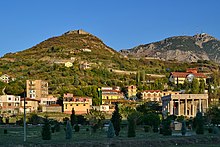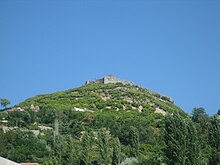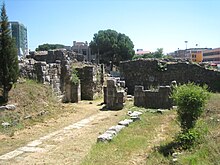Lezhë
Lezhë | |
|---|---|
Photomontage of Lezhë | |
|
UTC+2 (CEST) | |
| Postal Code | 4500 |
| Area Code | (0)215 |
| Website | lezha |
Lezhë (Albanian:
One of the main strongholds of the
Name
The city is mentioned in ancient sources as Lissós (Ancient Greek: Λισσός) and Lissus (Latin: Lissus, Lissum).[7] It is also attested in numismatic material. The ethnicon ΛΙΣΣΙΤΑΝ Lissitan is found on coin inscriptions of the Hellenistic era. It is considered a Greek toponym, deriving from the Greek λισσός'lissós, meaning 'smooth, smooth rock, gruff'.[8]
The ancient name Lissus evolved into its modern form Lezhë (archaic: Lesh[7]) through Albanian sound changes.[9] In Turkish, the town is known as Leş or Eşim and in Italian as Alessio. Lezhë is also known as Alise, Alexiensis, Eschenderari, or Mrtav.[10]
History
Early history

From the early Mycenaean period (1600-1450 BC) a free exchange pattern is confirmed with the centres of


In antiquity the area was described as the territory of the
The earliest of the fortification walls of the proto-urban settlement are of typical Illyrian construction and are dated to the late 4th century BC.[23] The transition from the Iron Age fortification of Acrolissus (on the 413 m Shëlbuem mountain) to the proper Illyrian city of Lissus was continuous. The city was built on a lower hill (172 m) near the Iron Age fortification.[11] It was surrounded by ramparts that faced the low valley of the Drin river and the sea coast. Its function was to guard the route inland, to ensure defense against possible attacks from the sea, and to furnish a secure anchorage for the Illyrian ships.[15]
By the 3rd century BC, Lissus was one of the main cities of the
In Roman times Lissus was located in a territory inhabited by the
Middle ages
During the reign of Justinian I (527-565) the local fortress was possibly mentioned as Alistion in the Synecdemus of Hierocles.[33] At early 590s Lissus was captured by Slavic populations.[34] Byzantine control was re-established during the early 9th century.[35]
Albanian lord Vladislav Jonima of the Jonima family was acknowledged by the Pope as a ruler of a territory around Lezhë in 1319. He had the title of Count of Dioclea and of the seaside Albania.[36] At the end of the 14th century, Albanian lord Dhimitër Jonima was lord of a territory between Mat and Lezhë.[37]
In the Middle Ages, Lezha (known in Italian as Alessio) frequently changed masters until the Venetians took possession of it in 1386. It still belonged to them when Skanderbeg died, but In 1478 it fell into the hands of Turks during the
Lezha was the site of the
Skanderbeg was buried in the cathedral of Lezhë which was dedicated to
Contemporary
Today Lezhë is a growing city. Its proximity to the port of Shëngjin as well as its location on the national road between the Montenegrin border to the North and Tirana to the South makes it an attractive location for industry and business.
Geography

Climate
As of the
| Climate data for Lezhë | |||||||||||||
|---|---|---|---|---|---|---|---|---|---|---|---|---|---|
| Month | Jan | Feb | Mar | Apr | May | Jun | Jul | Aug | Sep | Oct | Nov | Dec | Year |
| Mean daily maximum °C (°F) | 10.1 (50.2) |
11.7 (53.1) |
15.0 (59.0) |
18.9 (66.0) |
23.9 (75.0) |
27.6 (81.7) |
31.0 (87.8) |
30.9 (87.6) |
27.2 (81.0) |
21.6 (70.9) |
16.1 (61.0) |
11.7 (53.1) |
20.5 (68.9) |
| Mean daily minimum °C (°F) | 1.8 (35.2) |
3.0 (37.4) |
5.2 (41.4) |
8.8 (47.8) |
13.0 (55.4) |
14.7 (58.5) |
18.5 (65.3) |
18.2 (64.8) |
15.2 (59.4) |
10.9 (51.6) |
7.0 (44.6) |
4.2 (39.6) |
10.0 (50.1) |
| Average precipitation mm (inches) | 165 (6.5) |
143 (5.6) |
129 (5.1) |
118 (4.6) |
87 (3.4) |
60 (2.4) |
36 (1.4) |
52 (2.0) |
104 (4.1) |
136 (5.4) |
191 (7.5) |
179 (7.0) |
1,400 (55) |
| Average rainy days | 13 | 12 | 13 | 13 | 10 | 8 | 5 | 6 | 8 | 10 | 14 | 13 | 125 |
| Average relative humidity (%)
|
74 | 71 | 69 | 69 | 68 | 64 | 59 | 61 | 68 | 71 | 75 | 75 | 69 |
| Mean monthly sunshine hours | 130.2 | 130 | 173.6 | 201 | 269.7 | 306 | 362.7 | 322.4 | 258 | 207.7 | 138 | 117.8 | 2,617.1 |
| Mean daily sunshine hours | 4.2 | 4.6 | 5.6 | 6.7 | 8.7 | 10.2 | 11.7 | 10.4 | 8.6 | 6.7 | 4.6 | 3.8 | 7.2 |
| Source: Weather2visit[45] | |||||||||||||
Infrastructure
There are urban buses throughout the city and international and national buses. Lezhe has a train station not far from the center. The line starts in Durrës and ends in Shkodër. It is functional but not frequently.
The main highway in Lezhe is
Demography
The population of the municipality of Lezhë at the 2011 census was 65,633,[a] of which 15,510 in the city proper.[46]
Culture
The
From 2004 an excavation started around the ancient Acropolis of Lissos and the Skanderbeg Memorial, which revealed Hellenistic, Roman and Early Byzantine buildings, tombs and other findings.[47]
Notable people
- Antonio Bruti, 16th century merchant and diplomat
- Anton Kryezezi, Bishop of Lezhë
- Lekë Dukagjini, prince
- Jonima (Gjoni) familynoble family
- Gjergj Fishta, Catholic priest and poet
- Ndoc Gjetja, poet
- Henri Ndreka, football player, capped with Albania
- Robert Grizha, football player
- Erjon Dushku, football player
- Renato Malota, football player
- Ornel Gega, rugby union player
- Catholic Priest.
- Florjan Përgjoni, Albanian football player, born in Lezhë who currently plays for KF Tirana.
- Indrit Tuci, Albanian footballer born in Lezhë, currently plays for Sparta Prague.
See also
Notes
- ^ The population of the municipality results from the sum of the administrative units in the former as of the 2011 Albanian census.[39]
References
- ^ "Kryetari i Bashkisë" (in Albanian). Bashkia Lezhë. Archived from the original on 3 November 2021. Retrieved 8 November 2021.
- ^ Sedlar 2013, p. 111.
- ^ Waterfield 2014, p. 49.
- ^ Stylianou 1998, p. 194.
- ^ a b c Shehi 2015, p. 34.
- ^ Cabanes 2008, p. 177; Shehi 2015, p. 34
- ^ a b Gaffiot 1934, p. 915: "Lissus".
- ^ Lippert & Matzinger 2021, p. 132.
- ^ Katičić 1976, p. 186.
- ^ a b Catholic Encyclopedia, article "Alessio (Lissus, Alexiensis)"
- ^ a b Shpuza 2014, p. 118; Shehi 2015, p. 34
- ISBN 9789531631549. Retrieved 4 April 2020.
The variety of C and D type swords reported from central and northern Albania (Mat river valley, Lezhë, Shkodër), and their provenience from burial contexts, confirm the free exchange pattern with the Mycenaean centers of this part of the country, as in the early Mycenaean period.
- ^ Shpuza 2014, pp. 106, 116, 118: "All the sites described above are situated in the Lowlands of Shkodra, in small hills, which create a protection system of all the area. A similar fortification can be found also at Akrolissos, [...] The chronological framework for the dating of such fortifications is the Final Bronze Age and the Early Iron Age."
- ^ Elsie 2010, p. 272.
- ^ a b Wilkes 1992, p. 135; Cabanes 2008, p. 177
- ^ Matijašić 2011, p. 299; Boardman & Sollberger 1982, pp. 628–629
- ^ Wilkes & Fischer-Hansen 2004, p. 325: "In 385 Dionysios of Syracuse assisted the Parians to establish a settlement on Pharos, having already sent a colony to the Adriatic and founded “a city called Lissos” (no. 82) (Diod. 15.13.4)." p.332: "Lissos was founded shortly before 385 by Dionysios I [...] on the steep slope of a hill, modern Lezha [...] a site already occupied by Illyrian settlers."
- ^ Evans, A., Destani, B., Ancient Illyria, an archeological exploration. IB Tauris, 2007. p. 276.
- ^ Wilkes & Fischer-Hansen 2004, p. 332.
- ^ a b c Cabanes 2008, p. 177.
- ^ Wilkes 1992, p. 115: "It has been proposed that it was this place [Issa] and not Lissus far to the south at the mouth of the Drin from which help came to the Greeks on Pharos, since Issa lies only 25 miles away."
- ^ Wilkes & Fischer-Hansen 2004, p. 325: "The place from which Dionysios’ fleet came could be the later Illyrian fortress of Lissos (Lezhe) at the mouth of the river Drin in northern Albania, which has an impressive circuit of late Hellenistic masonry fortifications, but is more likely to be in fact the other Greek colony in the area, Issa (Vis) on the island of the same name and known from other evidence to be a Syracusan foundation."
- ^ Wilkes 1992, p. 135; Cabanes 2008, p. 177; Stylianou 1998, p. 194; Shehi 2015, p. 34
- ^ Wilkes 1992, pp. 161–162; Errington 1989, pp. 89–90
- ^ Wilkes 1992, pp. 162–163; Errington 1989, pp. 91–92
- ^ Papadopoulos 2016, p. 382.
- ^ Shpuza 2017, p. 43.
- ^ Polybius 8.13-14
- ISBN 9781845111670.
- ^ Shpuza 2014, p. 122.
- ^ Plutarch (1920). Life of Antony. Loeb Classical Edition. p. 7.4.
- ISBN 0-7156-3116-0,2003, page 233, of Lissus in Epirus Nova
- ISBN 978-0-7156-3201-7.
Also for Justinian's reign there survives a catalogue of towns in the Empire, the Synecdemus of Hierocles." "In Epirus Nova we find Apollonia, Byllis, Amantia, Pulcheropolis (Berat), Aulon (Vlore), Lychnidus (Ohrid) and the unknown Alistion, possible the modern Lezhe, and Skepton
- ISBN 978-1-5017-2940-9.
- ISBN 978-90-04-39519-0.
The fortress in Lezhe farther to the north along the coast of the Adriatic Sea, was reoccupied in the early 9th century
- ISBN 3-486-56569--9,
Vladislav Jonima, als Zupan, später als „Graf von Dioclea und Küstenalbanien"
- ISBN 99927-1-622-3p. 267
- ^ Schmitt Jens O.(2009) Skanderbeg, Der neue Alexander auf dem Balkan, Verlag Friedrich Pustet, pp. 55,56
- ^ a b c "Pasaporta e Bashkisë Lezhë" (in Albanian). Porta Vendore. Archived from the original on 8 November 2021. Retrieved 8 November 2021.
- ^ "A new Urban–Rural Classification of Albanian Population" (PDF). Instituti i Statistikës (INSTAT). May 2014. p. 15. Archived from the original (PDF) on 14 November 2019. Retrieved 8 November 2021.
- ^ "Law nr. 115/2014" (PDF) (in Albanian). pp. 6373–6374. Retrieved 25 February 2022.
- ^ "Strategjia Territoriale Bashkia Lezhë" (PDF) (in Albanian). Bashkia Lezhë. p. 10. Archived from the original (PDF) on 8 December 2020. Retrieved 8 December 2020.
- ^ "Bashkia Lezhë" (in Albanian). Albanian Association of Municipalities (AAM). Archived from the original on 8 November 2021. Retrieved 8 November 2021.
- ^ "Climate: Lezhë". Climate-Data. Archived from the original on 12 May 2019. Retrieved 8 November 2021.
- ^ "Lezhë monthly weather averages". weather2visit. Retrieved 23 February 2024.
{{cite web}}: CS1 maint: postscript (link) - ^ Nurja, Ines. "Censusi i popullsisë dhe banesave/ Population and Housing Census–Lezhë (2011)" (PDF). Tirana: Institute of Statistics (INSTAT). p. 84. Archived (PDF) from the original on 27 March 2020. Retrieved 8 November 2021.
- ^ Karl-Franzens Universitat, Lissus excavation report 2004. Archived 2011-06-29 at the Wayback Machine
Bibliography
- ISBN 978-90-04-32186-1.
- Boardman, John; Sollberger, E. (1982). J. Boardman; I. E. S. Edwards; N. G. L. Hammond; E. Sollberger (eds.). The Cambridge Ancient History: The Prehistory of the Balkans; and the Middle East and the Aegean world, tenth to eighth centuries B.C. Vol. III (part 1) (2 ed.). Cambridge University Press. ISBN 0521224969.
- Errington, R. M. (1989). "Rome and Greece to 250 B.C.". In A. E. Astin; F. W. Walbank; M. W. Frederiksen; R. M. Ogilvie (eds.). The Cambridge Ancient History: Rome and the Mediterranean to 133 B.C. Vol. VIII (2 ed.). Cambridge University Press. pp. 81–106. ISBN 0-521-23448-4.
- Eckstein, Arthur M. (2008). Rome Enters the Greek East: From Anarchy to Hierarchy in the Hellenistic Mediterranean, 230-170 B.C. Malden, MA.; Oxford: Blackwell Publishing.
- ISBN 978-0810861886. Archived from the original(PDF) on 6 October 2014.
- Gaffiot, Félix (1934). Dictionnaire Illustré Latin-Français. Hachette.
- Hammond, Nicholas Geoffrey Lemprière (1966). "The Kingdoms in Illyria circa 400-167 B.C.". The Annual of the British School at Athens. 61. British School at Athens: 239–253. S2CID 164155370.
- ISBN 978-9027933058.
- Lippert, Andreas; Matzinger, Joachim (2021). Die Illyrer: Geschichte, Archäologie und Sprache. Kohlhammer Verlag. ISBN 9783170377103.
- Matijašić, Ivan (2011). ""Shrieking like Illyrians": Historical geography and the Greek perspective of the Illyrian world in the 5th century BC". Arheološki Vestnik. 62: 289–316.
- Papadopoulos, John (2016). "Komai, Colonies and Cities in Epirus and Southern Albania: The Failure of the Polis and the Rise of Urbanism on the Fringes of the Greek World". In Molloy, Barry P.C. (ed.). Of Odysseys and Oddities: Scales and Modes of Interaction Between Prehistoric Aegean Societies and their Neighbours. Oxbow Books. pp. 435–460. ISBN 978-1-78570-232-7.
- Sedlar, Jean W. (2013). East Central Europe in the Middle Ages, 1000-1500. University of Washington Press. ISBN 9780295800646.
- Shehi, Eduard (2015). Terra sigillata en Illyrie méridionale et en Chaonie: importations et productions locales (IIe S. AV. J.-C. -IIe S. AP. J.-C.). Col·lecció Instrumenta (in French). Vol. 48. Barcelona: Universitat de Barcelona, Publicacions i Edicions. ISBN 978-84-475-4238-3.
- Shpuza, Saimir (2014). Dyczek, Piotr (ed.). "Iron Age Fortifications and the Origin of the City in the Territory of Scodra". Novensia. 25. Warszawa: Ośrodek Badań nad Antykiem Europy Południowo-Wschodniej: 105–126. ISSN 0860-5777.
- Shpuza, Saimir; Dyczek, Piotr (2015). "Scodra, de la capitale du Royaume Illyrien à la capitale de la province romaine". In Jean-Luc Lamboley; Luan Përzhita; Altin Skenderaj (eds.). L'Illyrie Méridionale et l'Épire dans l'Antiquité – VI (in French). Vol. 1. Paris: Diffusion De Boccard. pp. 269–278. ISBN 978-9928-4517-1-2.
- Shpuza, Saimir (2017). Dyczek, Piotr (ed.). "Scodra and the Labeates. Cities, rural fortifications and territorial defense in the Hellenistic period". Novensia. 28. Warszawa: Ośrodek Badań nad Antykiem Europy Południowo-Wschodniej: 41–64. ISSN 0860-5777.
- Stylianou, P. J. (1998). A Historical Commentary on Diodorus Siculus, book 15. Clarendon Press. ISBN 0-19-815239-6.
- Cabanes, Pierre (2008). "Greek Colonisation in the Adriatic". In ISBN 9789047442448.
- Waterfield, Robin (2014). Taken at the Flood: The Roman Conquest of Greece. OUP Oxford. ISBN 978-0-19-166414-4.
- ISBN 0-631-19807-5.
- Wilkes, J. J.; Fischer-Hansen, Tobias (2004). "The Adriatic". In Mogens Herman Hansen; Thomas Heine Nielsen (eds.). An Inventory of Archaic and Classical Poleis. ISBN 0-19-814099-1.
External links
- lezha.gov.al – Official Website (in Albanian)








